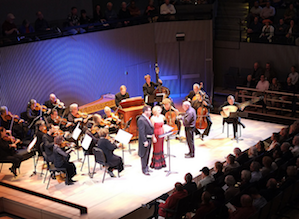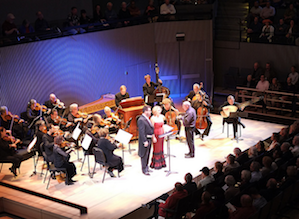
Philharmonia Baroque journeyed to two musical capitals simultaneously last night. One was Naples, where, thanks to the graces of soprano Carolyn Sampson and countertenor David Daniels, it reveled in the glories of music by Pergolesi and two of his contemporaries, Handel and Durante. The other was San Francisco’s SFJazz Center, whose Robert N. Miner Auditorium it explored for the first time. If Naples proved the more rewarding destination, it was in no small part due to conductor Nicholas McGegan’s ability to transcend acoustic limitations and coax the best from his wonderful orchestra and soloists.
There is no need for restraint when discussing those musical forces. While baroque aficionados hardly need another slew of superlatives to convince them that PBO is about as good as it gets, and that McGegan is so in love with his artists and repertoire that watching him is a show all in itself, they do need to hear Sampson in person at one of her two remaining Bay Area debut performances in Berkeley.
Sampson and Daniels
Since 2002, when the English period performance specialist issued her first recording at the age of 28, she has garnered an international reputation as one of our finest early music sopranos. It’s one thing to hear her on record; it’s another thing entirely to discover her voice transcending the limitations of a dry but truthful hall, and sparkling with a beauty and delight that confirms the copious gifts that life has to offer. Not only does Sampson produce a well-nourished and fresh sound at the bottom of her range, but she also rises to the top with a remarkable, light-filled clarity. In a far more resonant hall, such as Berkeley’s First Congregational Church, I expect her artistry to cast even more light on the sacred and love-filled aspects of Handel and Pergolesi's music.
SFJazz does not suck the life out of voices and instruments as did the old Herbst Theatre, which muddled their middle and muffled their bottom while stifling their top, but it does not permit highs to sparkle. Instead, it affects music as would a damped recording studio before artificial enhancement. You can tell exactly what’s there, but you need enlist your musical memory to add the natural resonance that classical music requires.
Miner Auditorium revealed that Sampson and Daniels’ production is flawless, and pitch impeccable. Their blend was gorgeous at the start of the duet, “Io t’abbraccio” (I embrace you) from Handel’s Rodelinda, and their perfect ritardando at the end of the first verse very touching. When Sampson rose in pitch, her sound was pure and exquisite. Perhaps because she was more warmed up than Daniels, or had tuned herself to the hall faster, her singing was softer and more touching at the start of the duet’s hushed recapitulation. But once past that only case of imbalance all evening, every duet was pure bliss.
On his own, Daniels performed “Dove sei” (Where are you, my beloved?) from Rodelinda. There are two versions of this aria; Daniels and McGegan began with a long held B on the word “Dove,” paused in a most effective and touching manner, and then continued to a shortened ritornello. It was wonderful.
With maturity, Daniels’ high range has gotten somewhat heavier, with the production seemingly farther back and thicker than of yore. (One choral professional in the audience likened the change to how the body of a fine wine matures with age.) But the beauty remains untarnished, and the emission enviably even. When, in his penultimate solo section in the Pergolesi Stabat Mater that ended the program, Daniels softened his voice to allow it to flow at its most mellifluous, the effect was especially heartwarming.
In “Da tempeste” (By storms), the first of two excerpts from Giulio Cesare, every note of Sampson’s coloratura was clear and perfectly formed. At one point, she rose flawlessly to a high C-sharp (in baroque pitch), and produced a wonderful high B in the cadenza. The capper was Cleopatra and Cesare’s zippy “Caro/Bella” duet, where Sampson’s slow “Caro” introduction was heaven-sent perfection, and the teasing close between the two, with McGegan barely containing his beaming jollies, a joy.
Stabat Mater
Shortly before his first performance with PBO in Atherton, Daniels wrote on his Facebook page, “I've always thought the Pergolesi Stabat Mater was [a] strange piece of music. Although beautiful, the text never really matched up with the music for me. It's just a little too jaunty and dance-like for sitting at the foot of the cross.” Surely he was thinking, for starters, of the “Quae moerebat et dolebat” (Who mourned and grieved) section, which must be the jolliest depiction of mourning ever lauded as a sacred masterpiece. While there are genuinely moving portions of Pergolesi’s final work — Sampson was ideal in the slow and sad “Vidit suum dulcem natum” (She saw her sweet Son dying …), and both artists managed to transcend jauntiness of the final “Quando corpus morietur” (When my body dies) to touch the heart — the perfection of the performance was best appreciated when translations were ignored, and the glories of the singing prevailed.
Instrumental Glories
If there was one advantage to SFJazz’ acoustic, it was that it allowed David Tayler’s often reticent theorbo to emerge from the orchestral fabric. This made the andante of Pergolesi’s Sinfonia from L’Olimpiade especially rewarding. In the closing Allegro vivace, I expect the delightful little chirping figures for violin to sing even more in “First Congo.” The inclusion of Durante’s Concerto for Strings No. 2 in G minor served to underscore Handel’s superior genius for conveying deep emotion. Nonetheless, the little “yip, yip, yip” sighs in the opening movement, and the wonderful pleading quality of the middle movement “largo,” set the stage for the Stabat Mater that crowned the not-to-be-missed program.

